Charles E W Bean, Diaries, AWM38 3DRL 606/275/1 - 1918 - 1938 - Part 11
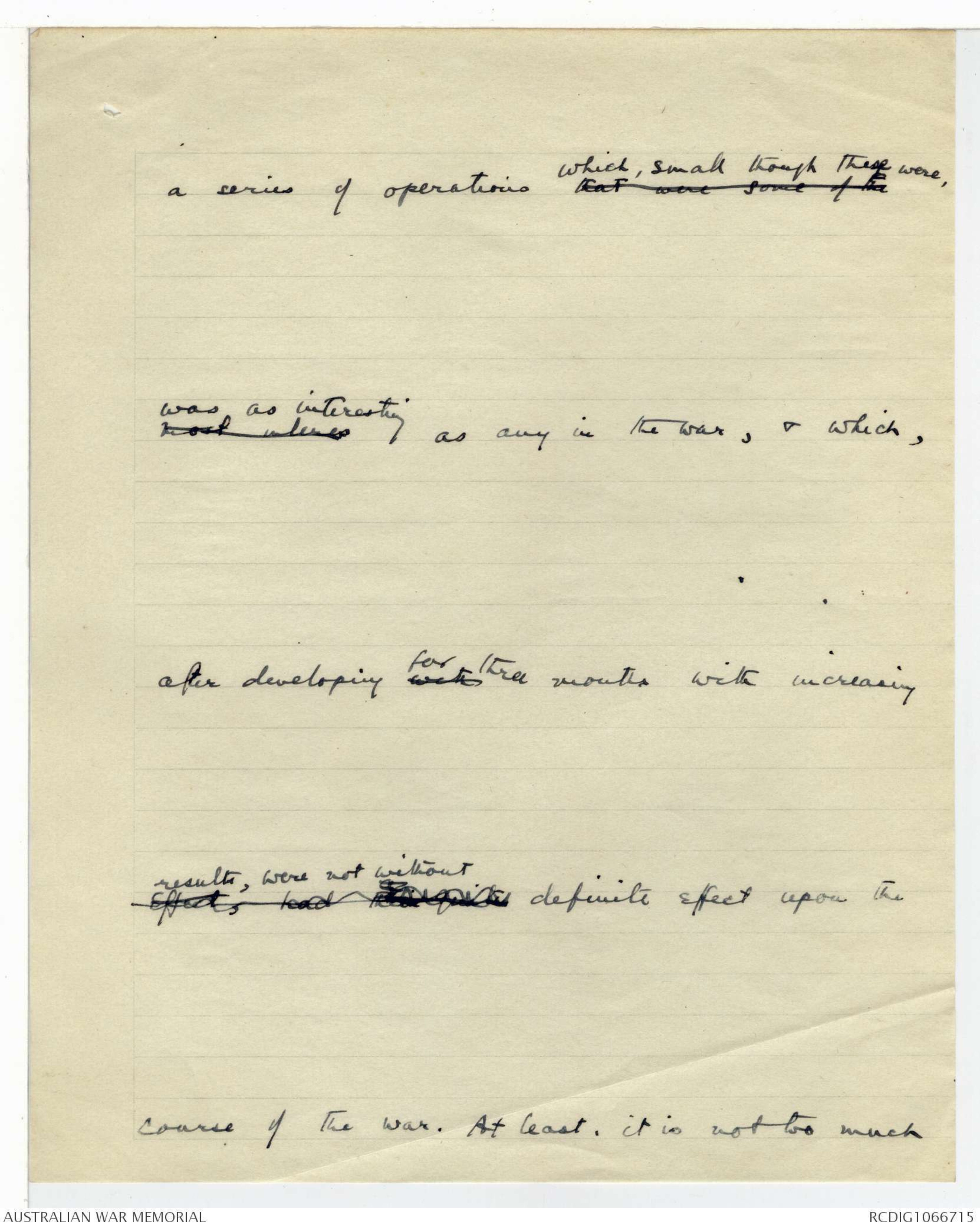
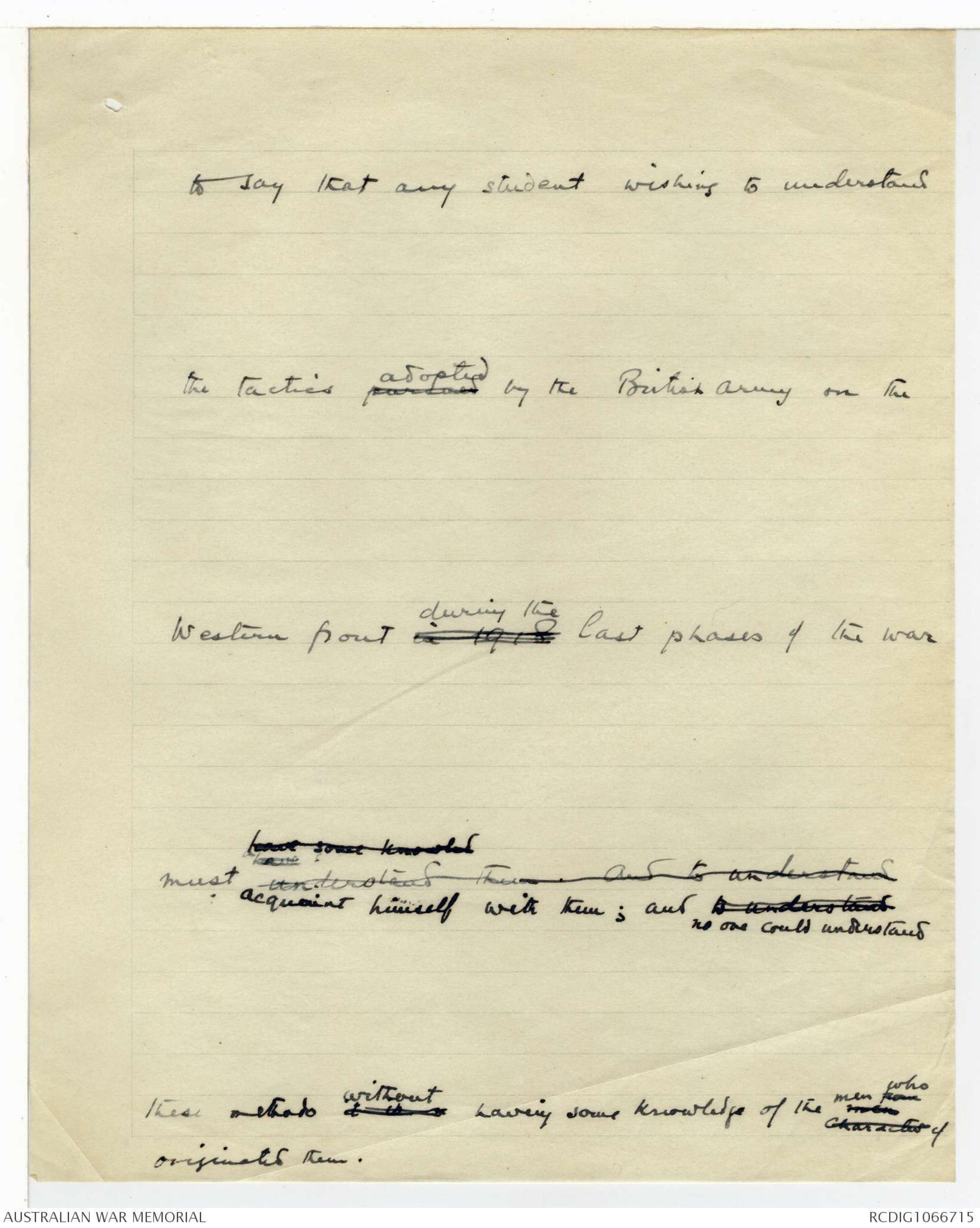
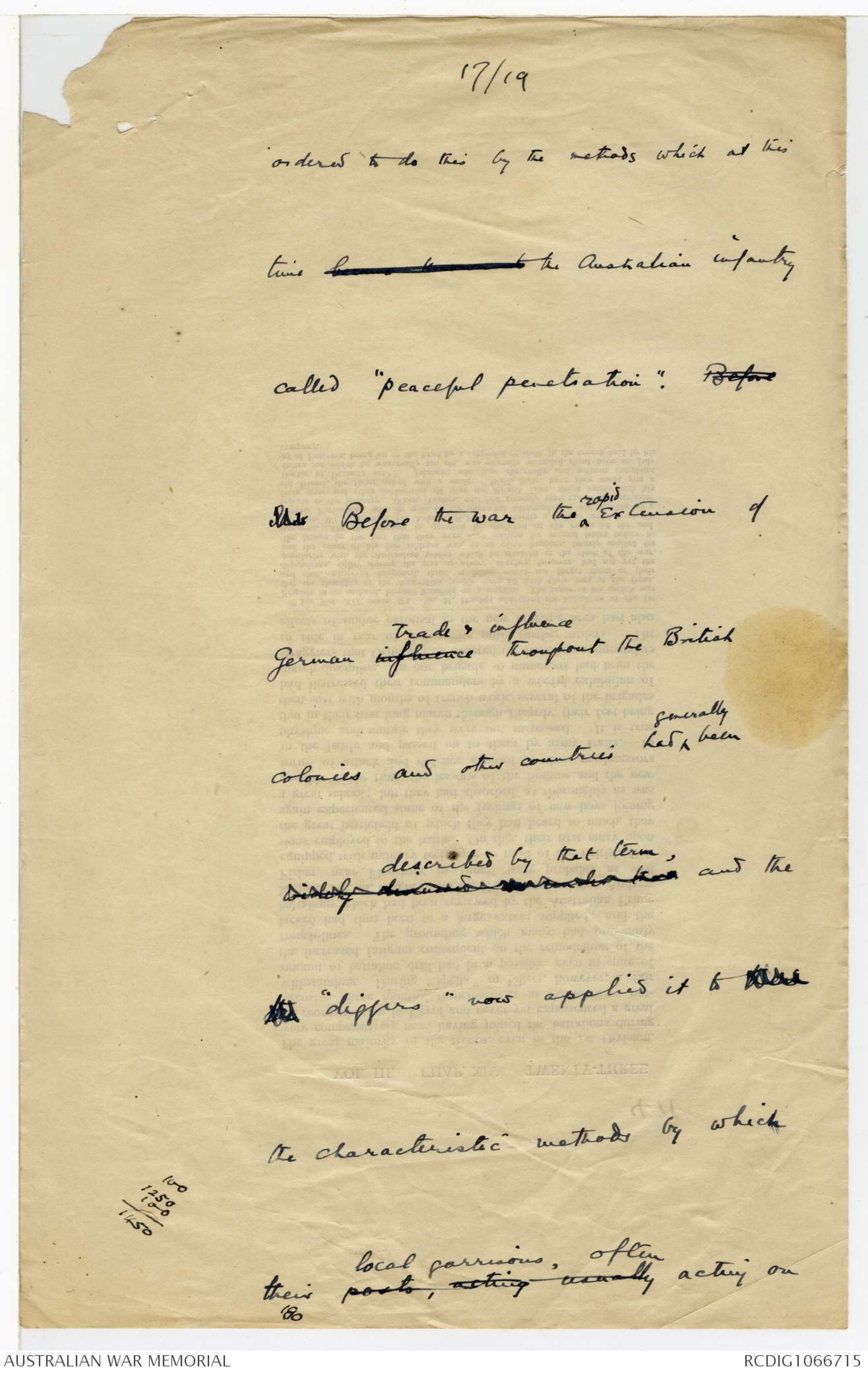
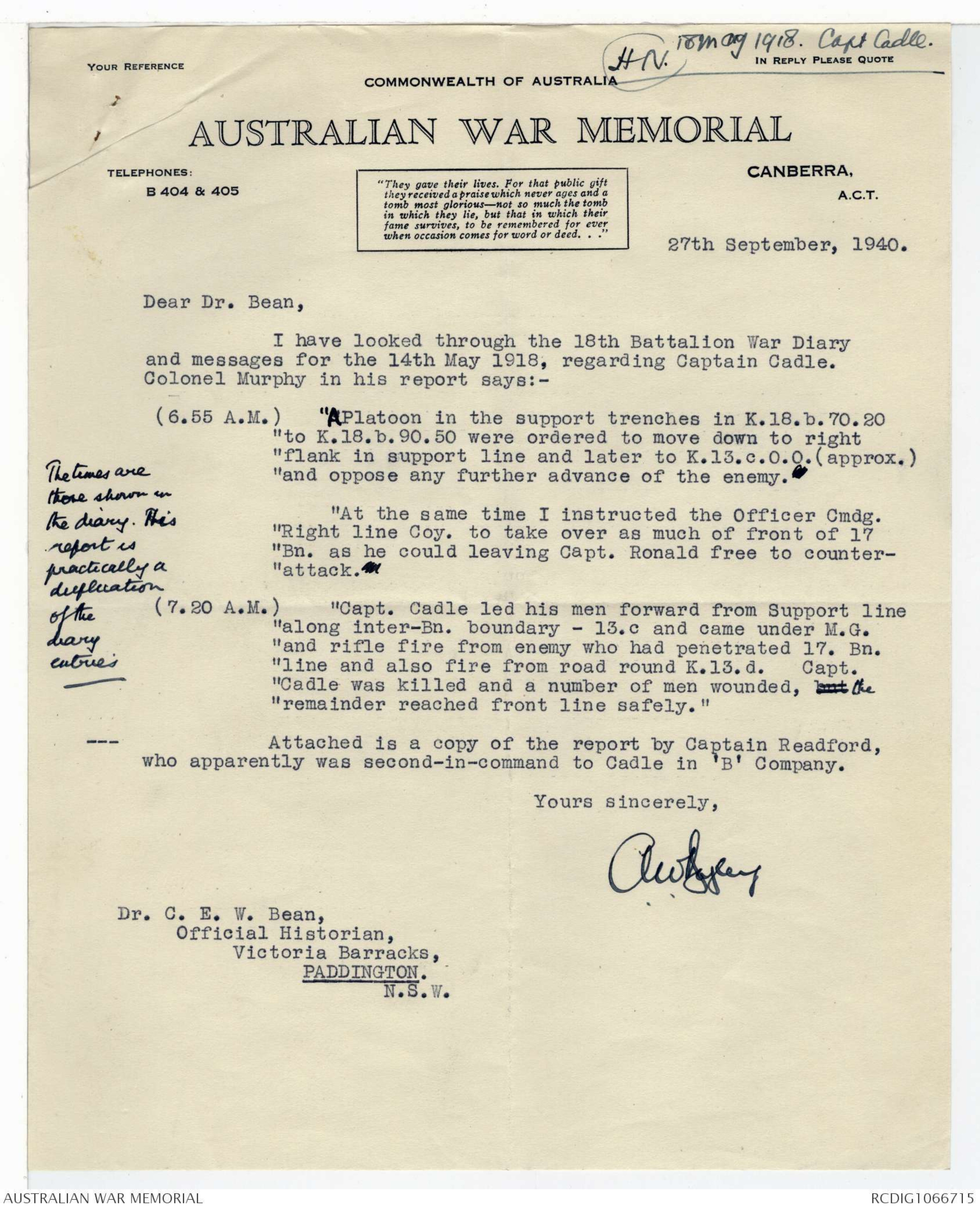
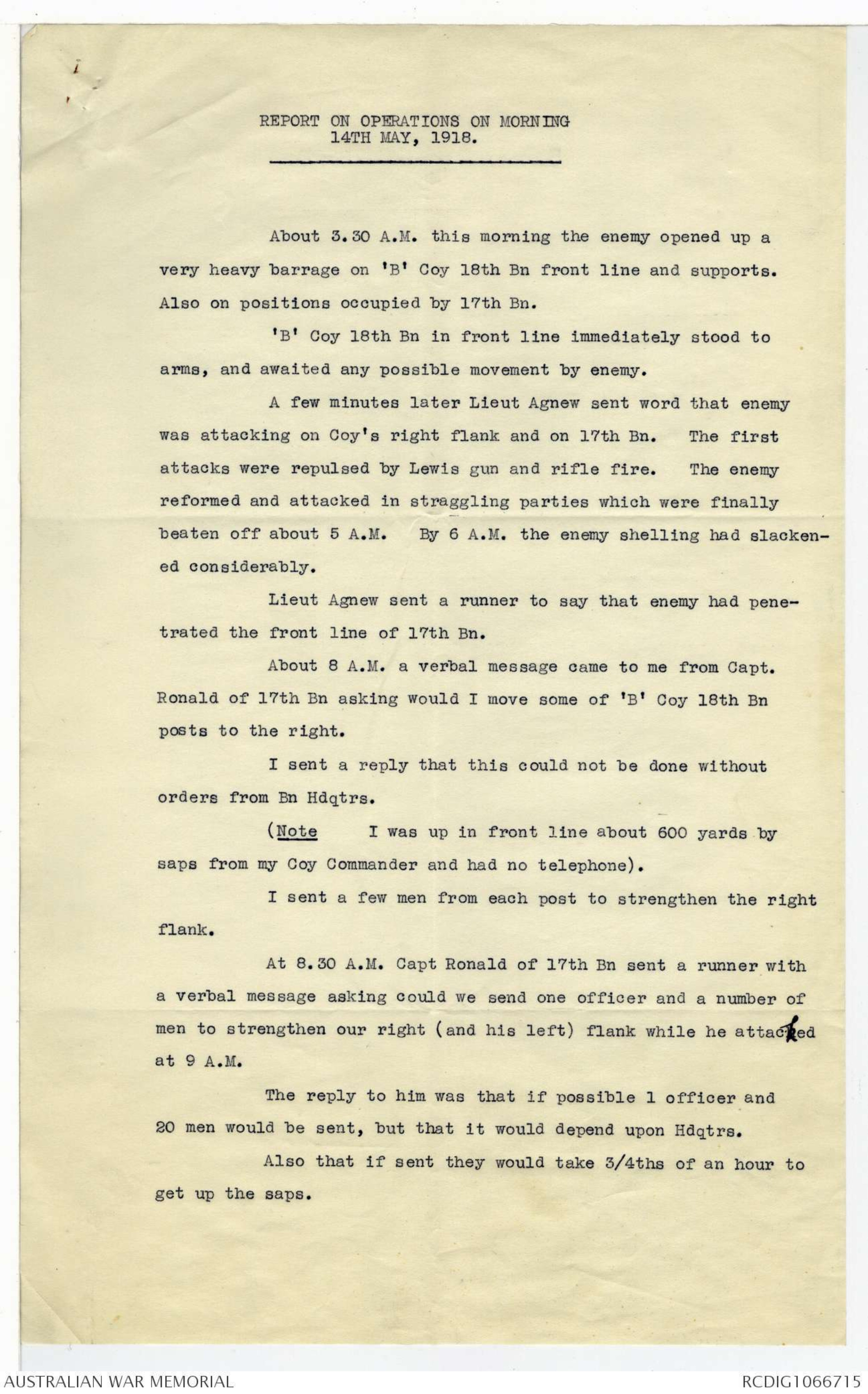

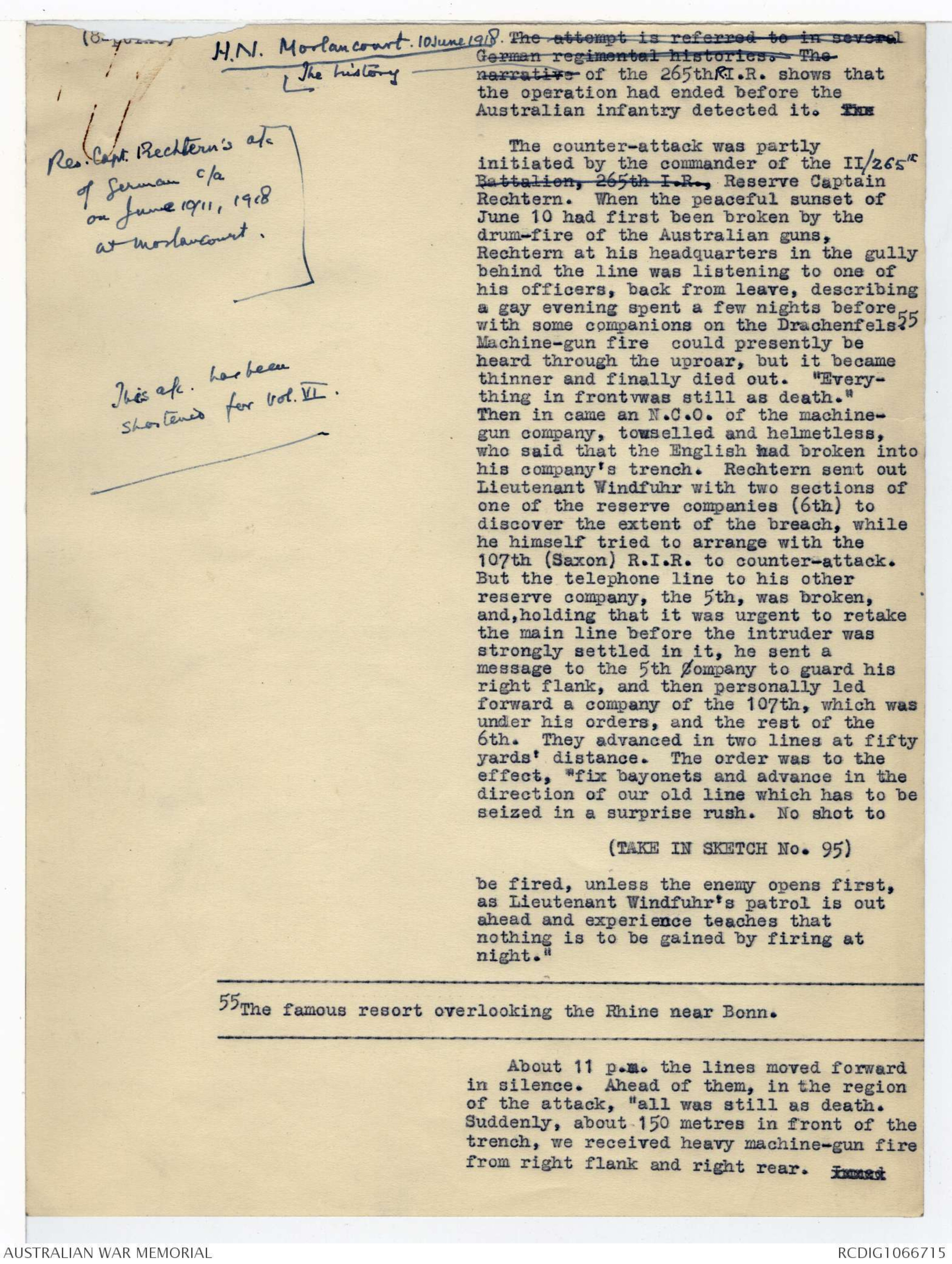
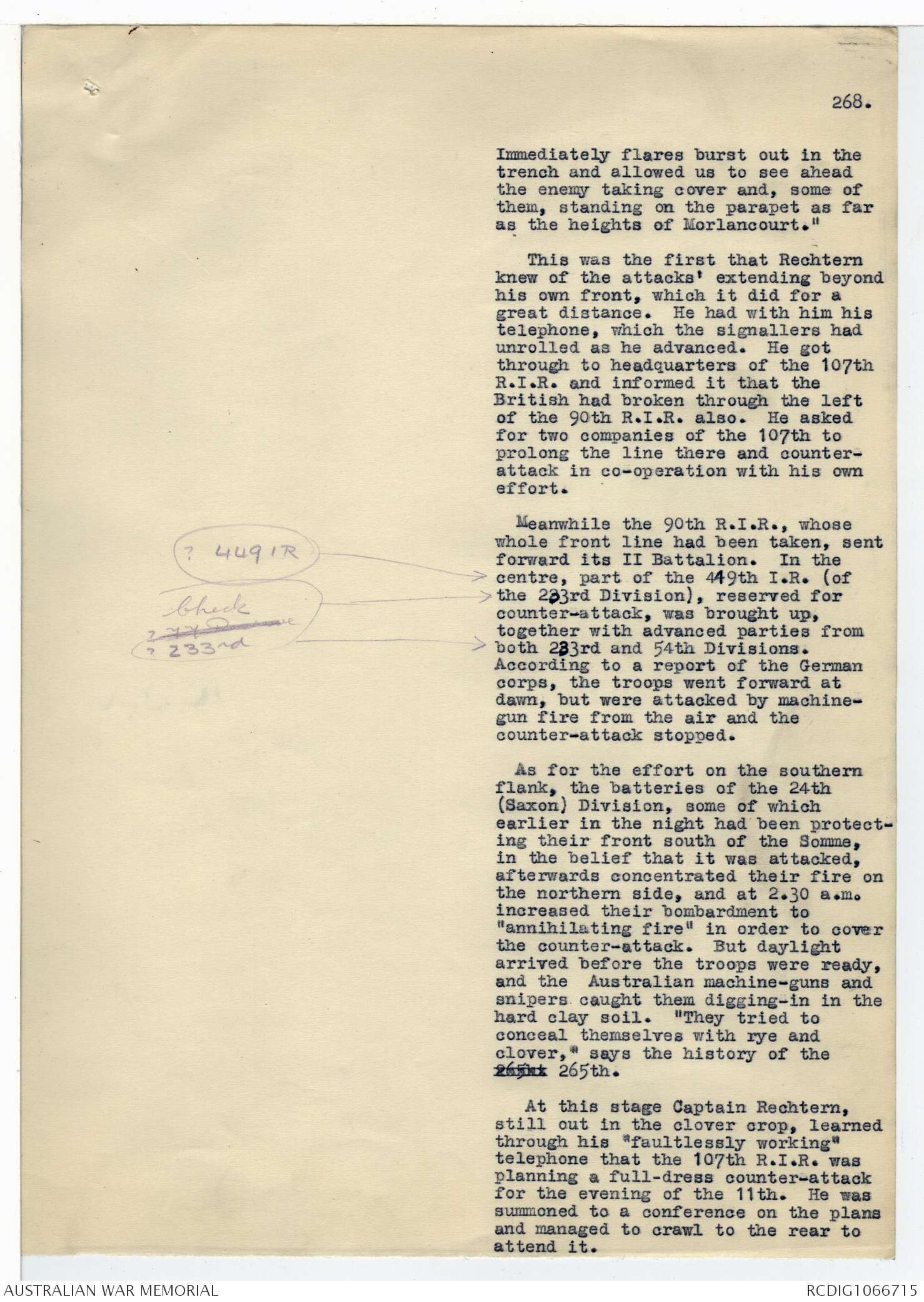
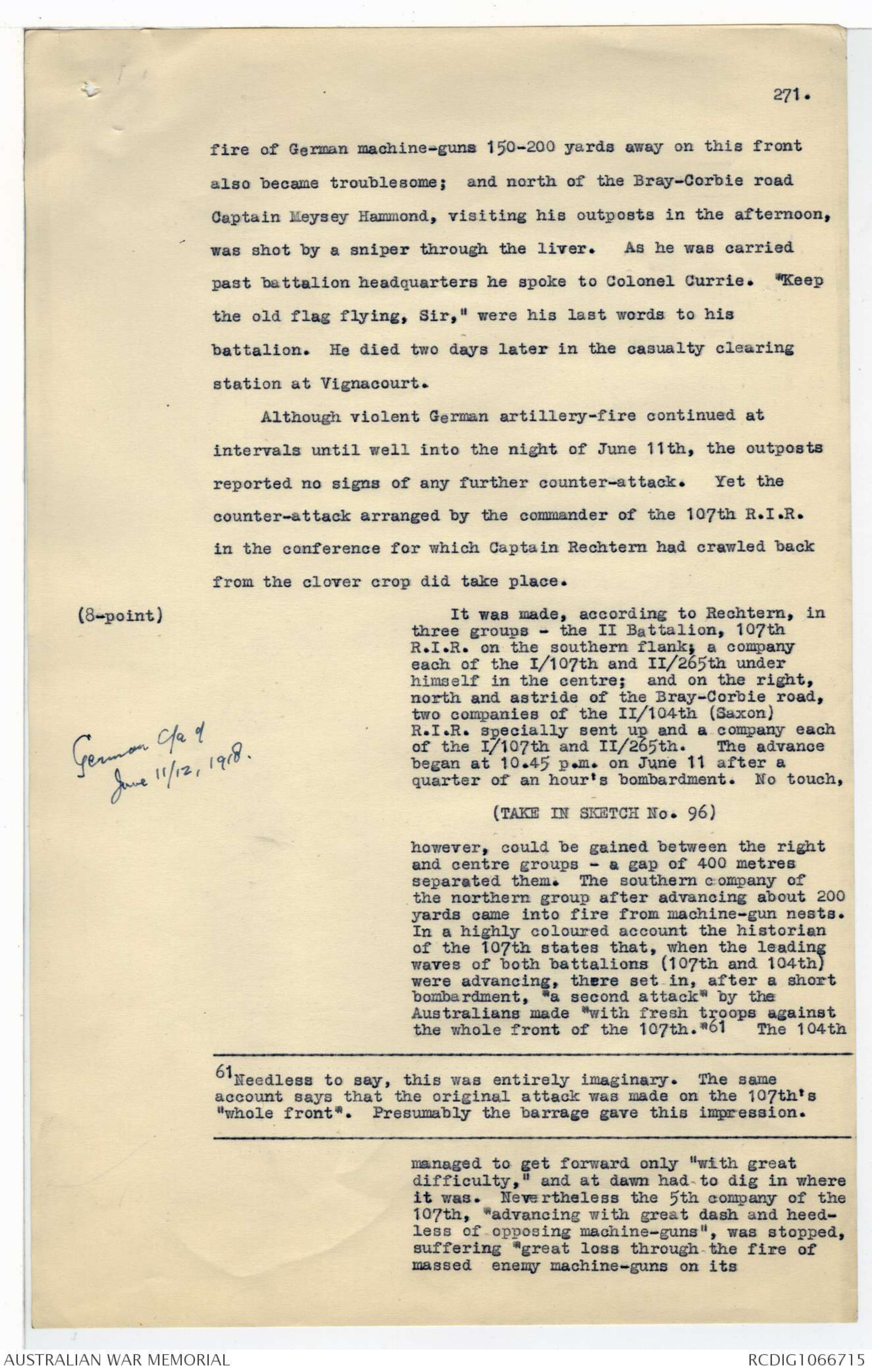
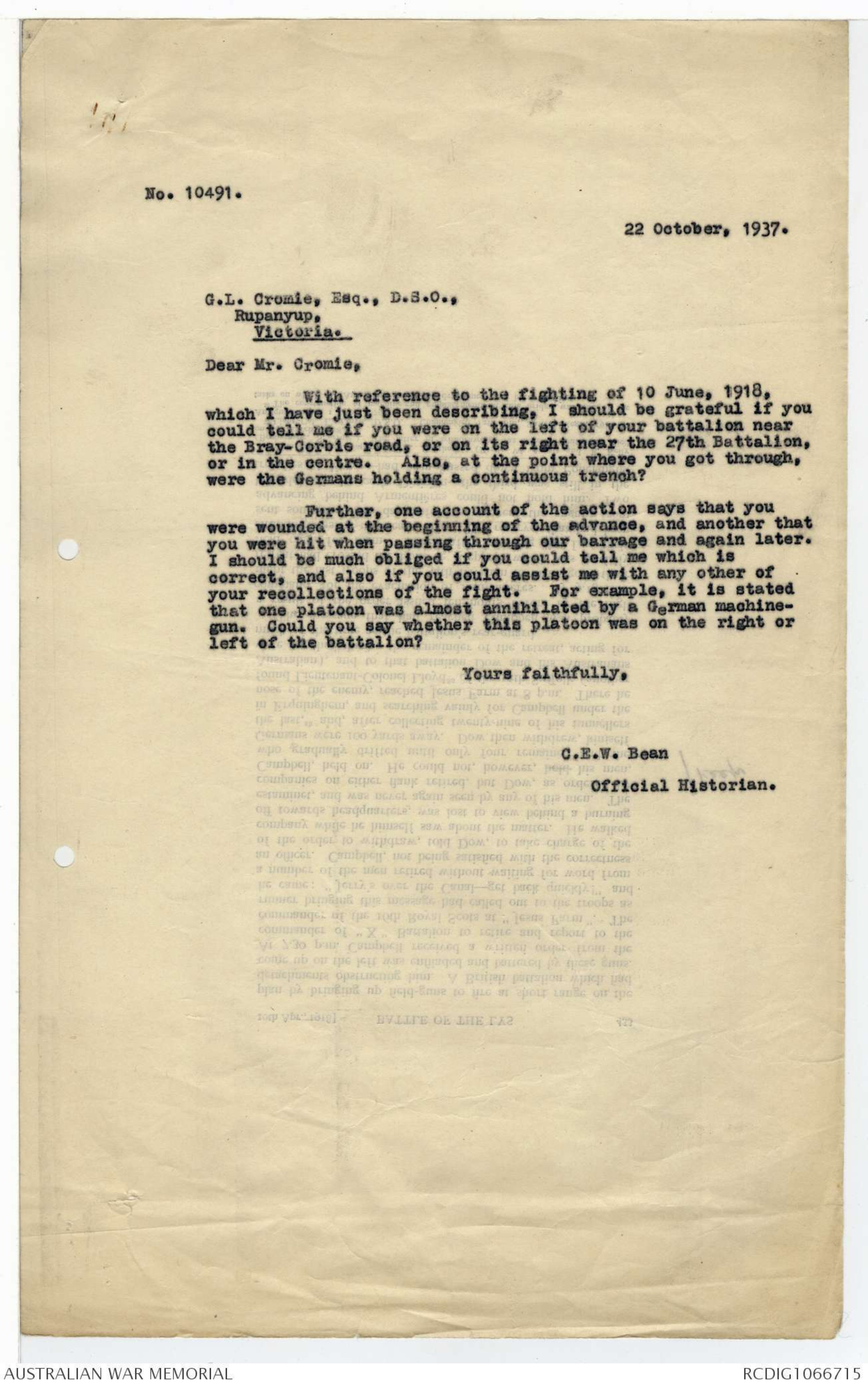
a series of operations that were some of the which, small though these were,most intense was as interesting as any in the war, & which,
after developing with for three months with increasingeffect, lead xxxxxxxxx results, were not without definite effect upon the
course of the war. At least, it is not too much
to say that any student wishing to understand
the tactics pursued adopted by the British Army on the
Western front in 1918 during the last phases of the warhave some knowledhave
must understand them. and to understand
acquaint himself with them; and to understand no one could understand
these methods at the x without having some knowledge of the men men from who character of
originated them.
17/19
ordered to do this by the methods at this
time xxxxxxxxxxxxxxxxx the Australian Infantry
called "peaceful penetration". Beforethat Before the war the ^rapid extension of
German influence trade & influence throughout the British
colonies and other countries had ^generally been
described by that term,xxxxxxxxxxxxxxxxxxxx and thethe "diggers" now applied it to those
the characteristic methods by which
[*100
1220
100
----
1450*]
their posts, acting usually local garrisons, often acting on
180
[*H.N. 18 May 1918. Capt Cadle.*]
YOUR REFERENCE IN REPLY PLEASE QUOTE
COMMONWEALTH OF AUSTRALIA
AUSTRALIAN WAR MEMORIAL
TELEPHONES:
B404 & 405
CANBERRA,
A.C.T.
"They gave their lives. For that public gift
they received a praise which never ages and a
tomb most glorious –not so much the tomb
in which they lie, but that in which their
fame survives, to be remembered for ever
when occasion comes for word or deed. . ."
27th September, 1940.
Dear Dr. Bean,
I have looked through the 18th Battalion War Diary
and messages for the 14th May 1918, regarding Captain Cadle.
Colonel Murphy in his report says:-
(6.55 A.M.) "A Platoon in the support trenches in K. 18. b. 70. 20
"to K. 18. b. 90. 50 were ordered to move down to right
"flank in support line and later to K. 13. c. 0. 0. (approx.)
"and oppose any further advance of the enemy."
"At the same time I instructed the Officer Cmdg.
"Right line Coy, to take over as much of front of 17
"Bn. as he could leaving Capt. Ronald free to counterattack."
(7.20 A.M.) "Capt. Cadle led his men forward from Support line
"along inter-Bn. boundary - 13. c and came under M.G.
"and rifle fire from enemy who had penetrated 17. Bn.
"line and also fire from road round K. 13. d. Capt.
"Cadle was killed and a number of men wounded, but the
"remainder reached front line safely."
--- Attached is a copy of the report by Captain Readford,
who apparently was second-in-command to Cadle in 'B' Company.
[*The times are
those shown in
the diary. His
report is
practically a
duplication
of the
diary
entries*]
Yours sincerely,
A W Begley
Dr. C. E. W. Bean,
Official Historian,
Victoria Barracks,
PADDINGTON.
N.S.W.
REPORT ON OPERATIONS ON MORNING
14TH MAY, 1918.
About 3.30 A.M. this morning the enemy opened up a
very heavy barrage on 'B' Coy 18th Bn front line and supports.
Also on positions occupied by 17th Bn.
'B' Coy 18th Bn in front line immediately stood to
arms, and awaited any possible movement by enemy.
A few minutes later Lieut Agnew sent word that enemy
was attacking on Coy's right flank and on 17th Bn. The first
attacks were repulsed by Lewis gun and rifle fire. The enemy
reformed and attacked in straggling parties which were finally
beaten off about 5 A.M. By 6 A.M. the enemy shelling had slackened
considerably.
Lieut Agnew sent a runner to say that enemy had penetrated
the front line of 17th Bn.
About 8 A.M. a verbal message came to me from Capt.
Ronald of 17th Bn asking would I move some of 'B' Coy 18th Bn
posts to the right.
I sent a reply that this could not be done without
orders from Bn Hdqtrs.
(Note I was up in front line about 600 yards by
saps from my Coy Commander and had no telephone).
I sent a few men from each post to strengthen the right
flank.
At 8.30 A.M. Capt Ronald of 17th Bn sent a runner with
a verbal message asking could we send one officer and a number of
men to strengthen our right (and his left) flank while he attacked
at 9 A.M.
The reply to him was that if possible 1 officer and
20 men would be sent, but that it would depend upon Hdqtrs.
Also that if sent they would take ¾ths of an hour to
get up the saps.
2.
I immediately wrote a message to the O.C. 'B' Coy
suggesting that Lieut Maxwell and 20 men (from No. 5 Platoon) be
detailed to come up up to strengthen 'B' Coy's right flank while
17h Bn (C. Coy) attacked at 9 A.M.
The runner also carried a verbal message that there
would be time to come up by the sap.
About 9.30 A.M. I was informed that Capt Cadle and
Lieut Maxwell and 20 men had advanced over the open, and that Capt
Cadle had been shot.
About 13 men of No. 5 Platoon were then collected, and
sent to strengthen the right flank.
The bad places in saps were deepened by working parties.
M. Readford Capt.
'B' Coy, 18th Bn.
14/5/18.
H.N. Morlancourt. 10 June 1918.The attempt is referred to in severalGerman regimental histories. Thenarrative ^The history of the 265th R.I.R. shows that
the operation had ended before the
Australian infantry detected it. The
[* Res. Capt. Rechtern's a/c
of German c/a
on June 10/11, 1918
at Morlancourt.*]
The counter-attack was partly
initiated by the commander of the II/265th
Battalion, 265th I.R., Reserve Captain
Rechtern. When the peaceful sunset of
June 10 had first been broken by the
drum-fire of the Australian guns,
Rechtern at his headquarters in the gully
behind the line was listening to one of
his officers, back from leave, describing
a gay evening spent a few nights before
with some companions on the Drachenfels.55
Machine-gun fire could presently be
heard through the uproar, but it became
thinner and finally died out. "Everything
in frontvwas still as death."
[*This a/c has been
shortened for Vol. VII.*]
Then in came an N.C.O. of the machine-
gun company, towselled and helmetless,
who said that the English had broken into
his company's trench. Rechtern sent out
Lieutenant Windfuhr with two sections of
one of the reserve companies (6th) to
discover the extent of the breach, while
he himself tried to arrange with the
107th (Saxon) R.I.R. to counter-attack.
But the telephone line to his other
reserve company, the 5th, was broken
and, holding that it was urgent to retake
the main line before the intruder was
strongly settled in it, he sent a
message to the 5th Company to guard his
right flank, and then personally led
forward a company of the 107th, which was
under his orders, and the rest of the
6th. They advanced in two lines at fifty
yards' distance. The order was to the
effect, "fix bayonets and advance in the
direction of our old line which has to be
seized in a surprise rush. No shot to
(TAKE IN SKETCH No. 95)
be fired, unless the enemy opens first,
as Lieutenant Windfuhr's patrol is out
ahead and experience teaches that
nothing is to be gained by firing at
night."
55 The famous resort overlooking the Rhine near Bonn.
About 11 p.m. the lines moved forward
in silence. Ahead of them, in the region
of the attack, "all was still as death.
Suddenly, about. 150 metres in front of the
trench, we received heavy machine-gun fire
from right flank and right rear. Immed
268.
Immediately flares burst out in the
trench and allowed us to see ahead
the enemy taking cover and, some of
them, standing on the parapet as far
as the heights of Morlancourt."
This was the first that Rechtern
knew of the attacks' extending beyond
his own front, which it did for a
great distance. He had with him his
telephone, which the signallers had
unrolled as he advanced. He got
through to headquarters of the 107th
R.I.R. and informed it that the
British had broken through the left
of the 90th R.I.R. also. He asked
for two companies of the 107th to
prolong the line there and counter-
attack in co-operation with his own
effort.
Meanwhile the 90th R.I.R., whose
whole front line had been taken, sent
forward its II Battalion. In the
[*? 4491R→*] centre, part of the 449th I.R. (of
[*Check→*] the 233rd Division), reserved for
counter-attack, was brought up,
together with advanced parties from
[* ?77 reserve ?233rd*]→ both 233rd and 54th Divisions.
According to a report of the German
corps, the troops went forward at
dawn, but were attacked by machine-
gun fire from the air and the
counter-attack stopped.
As for the effort on the southern
flank, the batteries of the 24th
(Saxon) Division, some of which
earlier in the night had been protecting
their front south of the Somme,
in the belief that it was attacked,
afterwards concentrated their fire on
the northern side, and at 2.30 a.m.
increased their bombardment to
"annihilating fire" in order to cover
the counter-attack. But daylight
arrived before the troops were ready,
and the Australian machine-guns and
snipers caught them digging-in in the
hard clay soil. "They tried to
conceal themselves with rye and
clover," says the history of the265xx 265th.
At this stage Captain Rechtern,
still out in the clover crop, learned
through his "faultlessly working"
telephone that the 107th R.I.R. was
planning a full-dress counter-attack
for the evening of the 11th. He was
summoned to a conference on the plans
and managed to crawl to the rear to
attend it.
271.
fire of German machine-guns 150-200 yards away on this front
also became troublesome; and north of the Bray-Corbie road
Captain Meysey Hammond, visiting his outposts in the afternoon,
was shot by a sniper through the liver. As he was carried
past battalion headquarters he spoke to Colonel Currie. "Keep
the old flag flying, Sir," were his last words to his
battalion. He died two days later in the casualty clearing
station at Vignacourt.
Although violent German artillery-fire continued at
intervals until well into the night of June 11th, the outposts
reported no signs of any further counter-attack. Yet the
counter-attack arranged by the commander of the 107th R.I.R.
in the conference for which Captain Rechtern had crawled back
from the clover crop did take place.
(8-point)
It was made, according to Rechtern, in
three groups - the II Battalion, 107th
R.I.R. on the southern flank; a company
each of the I/107th and II/265th under
himself in the centre; and on the right,
north and astride of the Bray-Corbie road,
two companies of the II/104th (Saxon)
R.I.R. specially sent up and a company each
of the I/107th and II/265th. The advance
began at 10.45 p.m. on June 11 after a
quarter of an hour's bombardment. No touch,
[*German c/a of
June 11/12, 1918.*]
(TAKE IN SKETCH No. 96)
however, could be gained between the right
and centre groups - a gap of 400 metres
separated them. The southern company of
the northern group after advancing about 200
yards came into fire from machine-gun nests.
In a highly coloured account the historian
of the 107th states that, when the leading
waves of both battalions (107th and 104th)
were advancing, there set in, after a short
bombardment, "a second attack" by the
Australians made "with fresh troops against
the whole front of the 107th.*61 The 104th
___________________________________________________________
61 Needless to say, this was entirely imaginary. The same
account says that the original attack was made on the 107th's
"whole front". Presumably the barrage gave this impression.
_____________________________________________________________
managed to get forward only "with great
difficulty, and at dawn had to dig in where
it was. Nevertheless the 5th company of the
107th, "advancing with great dash and heedless
of opposing machine-guns", was stopped,
suffering "great loss through the fire of
massed enemy machine-guns on its
No. 10491.
22 October, 1937.
G.L. Cromie, Esq., D.S.O.,
Rupanyup.
Victoria.
Dear Mr. Cromie,
With reference to the fighting of 10 June, 1918,
which I have just been describing, I should be grateful if you
could tell me if you were on the left of your battalion near
the Bray-Corbie road, or on its right near the 27th Battalion,
or in the centre. Also, at the point where you got through,
were the Germans holding a continuous trench?
Further, one account of the action says that you
were wounded at the beginning of the advance, and another that
you were hit when passing through our barrage and again later.
I should be much obliged if you could tell me which is
correct, and also if you could assist me with any other of
your recollections of the fight. For example, it is stated
that one platoon was almost annihilated by a German machine-gun.
Could you say whether this platoon was on the right or
left of the battalion?
Yours faithfully,
C.E.W. Bean
Official Historian.
 Sam scott
Sam scottThis transcription item is now locked to you for editing. To release the lock either Save your changes or Cancel.
This lock will be automatically released after 60 minutes of inactivity.